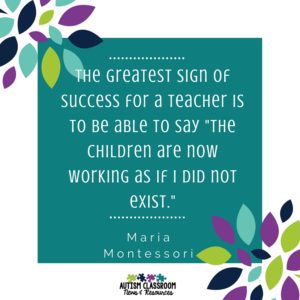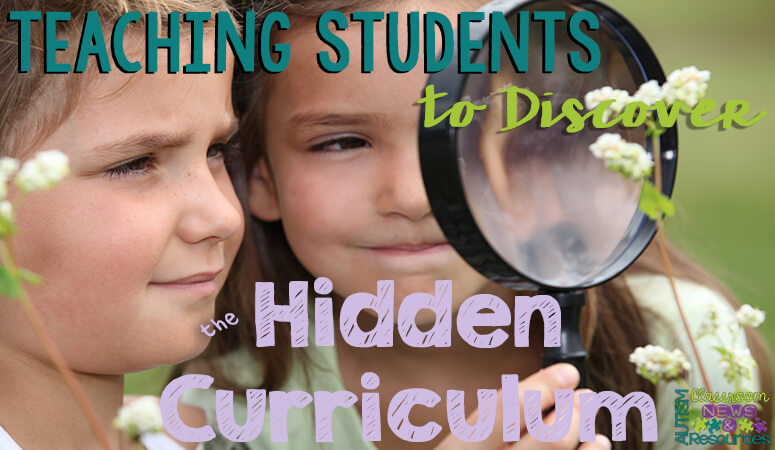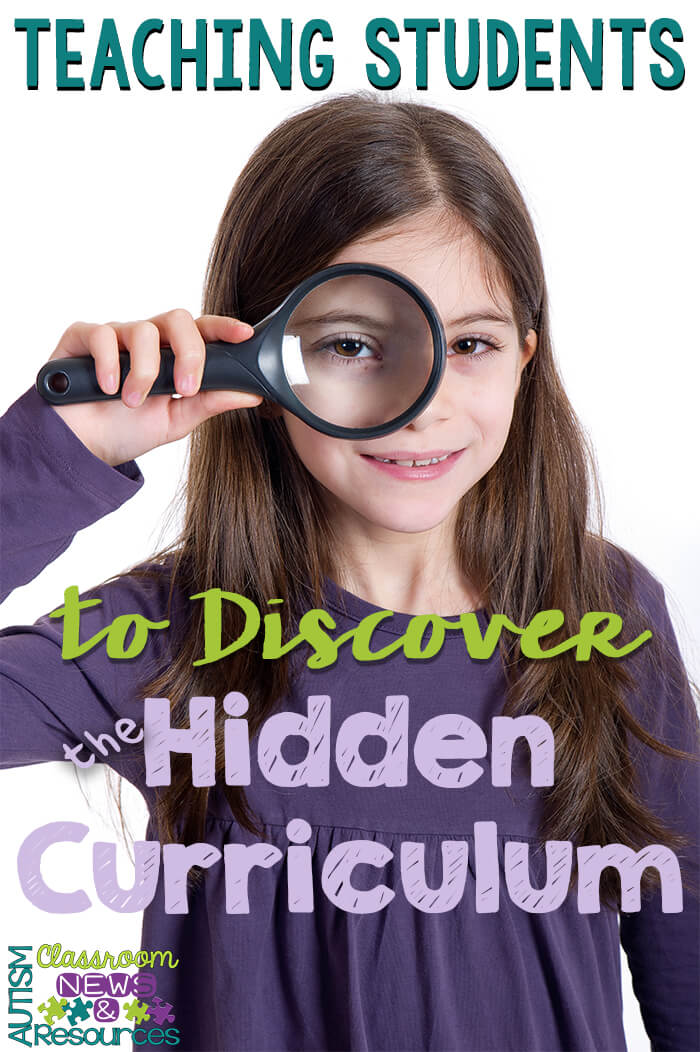Sharing is caring!
Ultimately our goal in any type of instruction should be to teach the students to learn on their own, and the hidden curriculum is no different. I’ve talked about the hidden curriculum, why it’s important, how to teach it one item at a time, and how to teach students a categorization strategy. The last piece of the puzzle is to teach students to figure out the unspoken rules on their own so that we don’t have to teach them every single piece and they don’t have to come into contact with a problem to learn each one.
Essentially there are two focuses to this approach. The first includes ways to accommodate the students’ current environments to help them notice relevant elements that give them information about appropriate behavior. The second includes strategies we teach the student to discover those relevant elements on their own in the future.
Accommodating Environments to Facilitate Learning the Hidden Curriculum
Before the students can learn the hidden curriculum on their own, we have to help them notice key elements in their environment that convey information. We do that with much of our social skills instruction when we try to teach them to understand how others are thinking, how to read facial expressions and how to try to interpret others’ behaviors. While we are teaching strategies, we also want them to be successful in their current environments. To do this, we first assess the student’s environment.
For instance, you might ask some of the following questions:
- Does he/she interact with multiple teachers or staff?
- What are teachers’ expectations for behavior (e.g., taking a break from class, getting a drink, going to the bathroom, ask questions)?
- What are teachers’ expectations for academics / work (e.g., turning in homework, giving extensions)?
- What are the expectations in the common areas of the school (e.g., bathroom, lunchroom)?
- Does the student know the rules of the school? Do the rules cover areas that might be an issue for him? In other words, read the high school policy manual. You would be amazed what isn’t covered that our students can get tripped on. There may be 15 pages on drugs in school but none on appropriate clothing or appropriate touching on school grounds.
From those questions, think about what the student needs to know in order to be successful and teach those initial items directly. For instance, I worked with a student who tended to put his head down on his desk or get out a book when he already knew the information the teacher was teaching. Some instructors were fine with this because he was a very smart student and they knew he already knew the information. Others were offended and he frequently got in trouble for those behaviors in those classes. This became a teaching moment for both the teachers and the student. We tried to help the teachers understand that it wasn’t a personal attack or show of disrespect while we simultaneously taught the student which classes he could do this behavior in and which he couldn’t. Later we taught him how to figure that out on his own.
Then we need to develop some strategies that we teach the student to use when we can’t teach a rote, black and white type of response (e.g., don’t ever do ___). Some examples of strategies you might teach include:
- Use a laser pointer to help child follow what the teacher is talking about on the board. Teach the student to attend to where the laser pointer is to find the relevant information.
- Identify key phrases that the child can listen for that the teacher that can indicate the need to attend (e.g., this may be on the test).
- Have the teacher help identify the phrases she uses commonly and teach the student those phrases.
- Tell the student the rules for assignments, homework, extensions and the like for each class or instructor. Write them down and keep them handy in a notebook or a set of cards the student can refer to at first.
Teaching Strategies for Uncovering the Hidden Curriculum
 Clearly, students can’t have someone by their sides forever telling them the hidden curriculum, so our ultimate goal is always to teach students to be self-sufficient in finding it and figuring out how to behave. We can do that by teaching them some strategies and having them practice them in a protected setting until they mater them.
Clearly, students can’t have someone by their sides forever telling them the hidden curriculum, so our ultimate goal is always to teach students to be self-sufficient in finding it and figuring out how to behave. We can do that by teaching them some strategies and having them practice them in a protected setting until they mater them.
Some strategies we might teach include:
- Use a 5-Point Scale for assessing social perspective–how well do you understand others’ perspectives in specific situations. For instance, you might understand the social perspective of your best friend better than a stranger. Then make decisions according to how well you think you know what the other person wants (e.g., making assumptions about how to behave with your friend is better than making assumptions with a stranger).
- Ask questions. Sometimes it’s as simple as giving students permission to ask questions and teaching them to advocate for themselves. For instance, if you don’t know the proper attire for an event, ask that person. If you aren’t sure of the expectations of a teacher, self-advocate and ask after the first class meeting to avoid problems.
- Watch those around you. Teaching students to imitate those around them, through the use of modeling and video modeling, can be useful because it helps us know how to behave in unfamiliar situations. For instance, when I used to go with a friend to Catholic Mass (I’m not Catholic), I watched him to see when he stood and kneeled to know how to behave.
- Develop a safe person. This is a strategy that comes from Brenda Smith Myles who has written several books about the hidden curriculum (see below). This person is someone that can be trusted to have the student’s best interest at heart at all times. It might be a family member or a best friend and there might be several people who serve this purpose. We all have safe people or people we know are going to have a good idea of how we should behave in certain situations. I have friends I go to when I need to know what I should wear to a party and other friends I go to when I want to know how to respond when a family member of a friend dies. Essentially this involves learning to ask questions, but it also involves knowing who is safe and will give you an honest answer and not an answer that might get you in trouble and set you up for more problems. Identifying the safe person can be helpful because our students don’t always know who that person is and can get into trouble asking the wrong people. For instance, it might not be a problem if you ask your friend if your breath smells before you walk into a job interview. However, if you ask the person you are interviewing with, it might be.
- Teach problem solving. Finally, when something does happen or go awry and the student misses the hidden curriculum or social cues, it can helpful to teach them a problem solving strategy. Not all problems can be avoided and students should be taught how to recognize and cope with the occasional faux pas. We’ve all experienced them at times and are embarrassed, but realize it’s how we react that really makes the impression. Using something like a social autopsy (see #5) to help students figure out what the problem was and what to do next time can be a good life-long strategy to help them figure out when there is an error and how to handle it in the future.
There are several types of resources that can help you teach the hidden curriculum to students with autism and related disabilities. Below are some affiliate links to common books I’ve used to help teachers know about the hidden curriculum and what items to teach as well as to help students learn about them on their own. For instance, the book How Rude is an excellent resource for the students because it’s funny but very matter of fact in giving information about expectations. Just make sure to review the information in the book before using it as some of it focuses on situations that might be too advanced (e.g., dating and sex) for some students.
If you want to know more about the hidden curriculum there are some books linked with affiliate links below.
Disclosure: *Affiliate links just mean that I get a small commission if you purchase them but I wouldn’t recommend them if I didn’t think they were useful.
For Students:
For Teachers:
That’s it for the hidden curriculum. I’ve got a few things up my sleeve with some live video and other things coming, so make sure to subscribe to the newsletter to get all the upcoming details!
Until next time,








